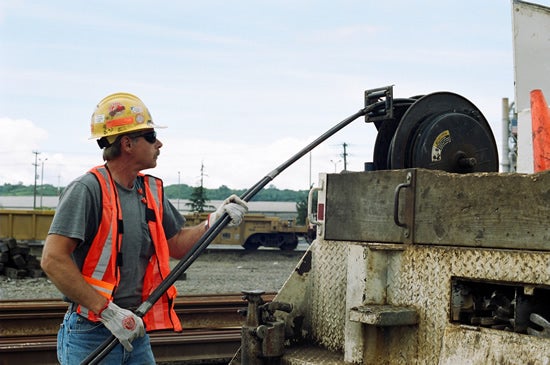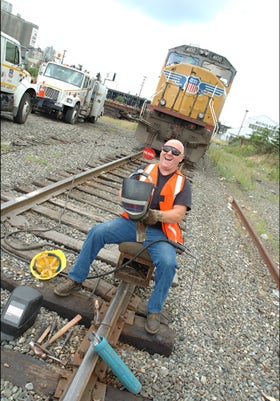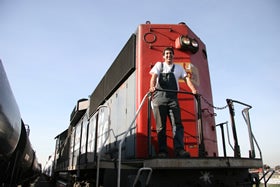Uncategorized
National Freight Rail Contract Ratified

Higher pay, job stability and strong benefits are the key ingredients for a contract and the core of the new freight rail contract ratified this year by members of the Teamsters Rail Conference. The nearly 70,000 members of the Rail Conference (about 35,000 in the Brotherhood of Locomotive Engineers and Trainmen, or BLET, and 34,000 members of the Brotherhood of Maintenance of Way Employes, or BMWED) have a personal commitment to the industry which is mirrored by the new freight rail agreement.
 Freight rail traffic in the U.S. has been growing in recent years as industries such as coal and gas have needed to move large amounts of product across country on a reliable transportation network. Yet, negotiations for a national freight rail contract this past year, which was ratified in 2012, was rife with claims by the rail corporations that they couldn’t possibly afford wage increases for unionized workers.
Freight rail traffic in the U.S. has been growing in recent years as industries such as coal and gas have needed to move large amounts of product across country on a reliable transportation network. Yet, negotiations for a national freight rail contract this past year, which was ratified in 2012, was rife with claims by the rail corporations that they couldn’t possibly afford wage increases for unionized workers.
Members of the Teamsters Rail Conference persevered and won wage increases for the entire term of the six-year contract, along with maintaining a strong health care plan. Both the BLET and the BMWED participated in the Rail Labor Bargaining Coalition, along with five other rail unions. This combined strength allowed the coalition to reach a good agreement with the railroads, who, by the way, have been making record profits now for several years.
The wage portion of the contract provides for an average 3.2 percent annual wage increase for each of the six years along with a significant lump sum payment during the first year. Health care benefits are maintained at the same level as before, but with some cost adjustment for particular expenses. This benefit plan remains one of the best in the American labor movement.
Belonging Allows Access
Craig Thurow, a BLET engineer from North Dakota, believes that one of the best reasons to be a rail union member is to never have a concern about losing your health insurance. “We are secured by a collective agreement. I am thankful for it. I’ve been working on Canadian Pacific (CP) for the past 34 years and our benefits have always been there.”
Thurow’s godfather was a conductor on the Soo line, which is how he first learned about the rail business. “Growing up in a rural community, there weren’t many union jobs around,” Thurow said. “My life is so much better being part of the union.”
 Despite the rural nature of the area, business is booming in the Bakken oil line located in western North Dakota. Not only is Thurow’s local division for CP involved, but so are members of the Burlington Northern Santa Fe (BNSF) at a neighboring division. “Bakken has grown so large in oil production that we are number two behind Alaska,” Thurow said. “Our crew base has multiplied nearly four times its original size since I joined in 1979.”
Despite the rural nature of the area, business is booming in the Bakken oil line located in western North Dakota. Not only is Thurow’s local division for CP involved, but so are members of the Burlington Northern Santa Fe (BNSF) at a neighboring division. “Bakken has grown so large in oil production that we are number two behind Alaska,” Thurow said. “Our crew base has multiplied nearly four times its original size since I joined in 1979.”
A BMWED member, Terry Barrette values the additional training he has taken as a result of his union membership. Barrette is confident that it’s only due to his membership in the union that he and his family have been provided for over the years.
“There are people who have been working and struggling for years, but being a union member, I’ve been able to provide for me and my family,” Barrette said. “In our lodge we even have younger people who are able to buy a condo, all because they have the promise of a stable job. I’m going to be able to retire at age 60 with a full pension and good insurance.”
Barrette has been able to get extra training on a variety of topics: hazardous materials handling, first observer, local chairmen seminars, etc. “Part of the benefit of being affiliated with the Teamsters Union is our access to training courses, and certainly having the political clout of the Teamsters behind us has brought our concerns for workplace safety and the need to rebuild the rail infrastructure to the forefront,” Barrette said.
Union Tradition
“For me, union membership has been a tradition in my family. I know the importance of working under a collective bargaining agreement,” said Gene Thompson, a nine-year BMWED member based in Alliance, Neb. “I work at the yard in Alliance on switch renewals and day-to-day maintenance.”
Thompson, whose father-in-law and sister worked for Burlington Northern Santa Fe, said that being part of a union was something he learned years ago. The pay and the benefits, such as weekends off, were parts of having a union contract that appealed to him.
“With the new national freight contract we are getting a 19-percent wage increase over the course of the six-year agreement,” Thompson said. “And for the first time we will have single-occupancy rooms when we are on long-term, away-from-home jobs. It’s been the single biggest complaint about the job since I started nine years ago.”
Retaining a strong health care plan was a concern for Thompson whose family has two small children, ages 5 and 2. “Our health care plan is one of the best around,” Thompson said. “We go to Denver to the doctor and I am glad we can. Everyone struggles with health care.”
For Thompson and his family, having a union contract he can depend on is far superior to other employment opportunities where he lives. Largely an agricultural region, many people put in long hours and are not well compensated. “Being part of the union is absolutely better,” Thompson said. “I’m involved in my local lodge, too. I just got elected as an officer in January and have since taken some training for lodge officers.”
Although having a full-time job is a juggling act for Thompson, his commitment to the union and his family is strong. “I am thankful that I have a good-paying job,” Thompson said. “It allows my family and me to enjoy life.”
California High-Speed Rail Gets Boost
Legislators Pass Bond Measure
For more than two years, Tim Smith, a BLET member and chairman of the BLET’s California legislative board, has been working to educate legislators on the crucial need to fund high-speed rail.
“We were anticipating the vote this summer and are very happy that both houses of the California legislature gave the green light in July to high-speed rail funding,” Smith said.
The new rail system would be the largest public works project in the state and could potentially employ hundreds of unionized locomotive engineers, trainmen and maintenance of way workers. California’s system would be built around the Los Angeles basin from Anaheim to Merced. The next phase would be from the San Francisco peninsula to Merced. Although there is a heavy reliance now on cars and planes for transportation, studies show that ridership will be there as an alternative to flying and driving.
“With the passage of this legislation, we have an opportunity to show Californians the skills and hard work our members bring to the rail profession,” said Freddie N. Simpson, President of the BMWED and International Vice President of the Teamsters Union.
Dennis Pierce, Rail Conference President and National President of the BLET, said the direction that California is going now will serve as a model for other areas. “The California high-speed rail line will be a beacon of performance on the West Coast and our members look forward to operating equipment on this state-of-the-art rail line,” Pierce said.
Cities from Los Angeles to San Francisco are making preparations for the arrival of high-speed rail. Even smaller cities, such as Modesto, population 201,000, are holding town hall meetings to gather citizen input about where to locate stations. At a recent public meeting in Modesto, members of the Teamsters and Laborers unions joined other residents to look over plans on where to locate the city’s new rail. Even though there were disagreements about which streets could be closed and how large the station should be, the desire for and anticipation of having high-speed rail access was palatable in the meeting room.